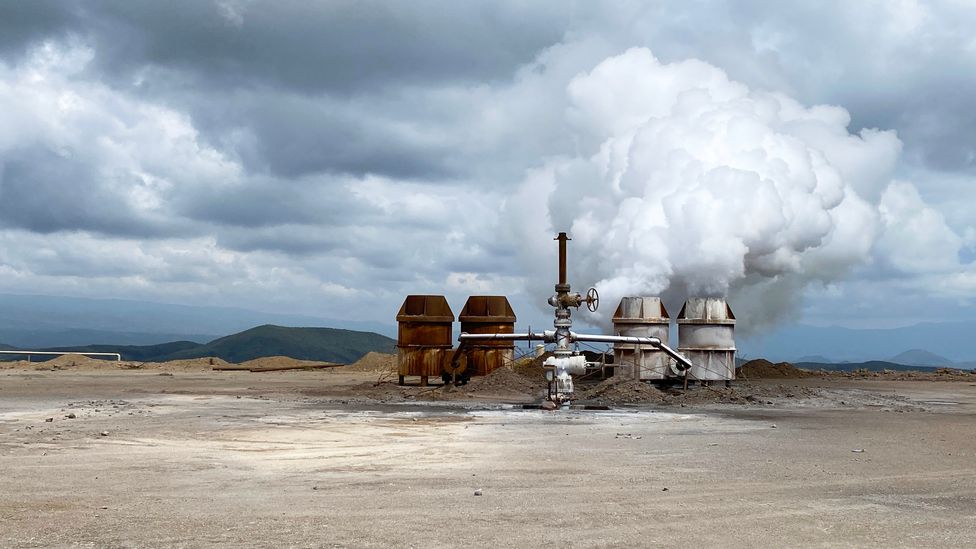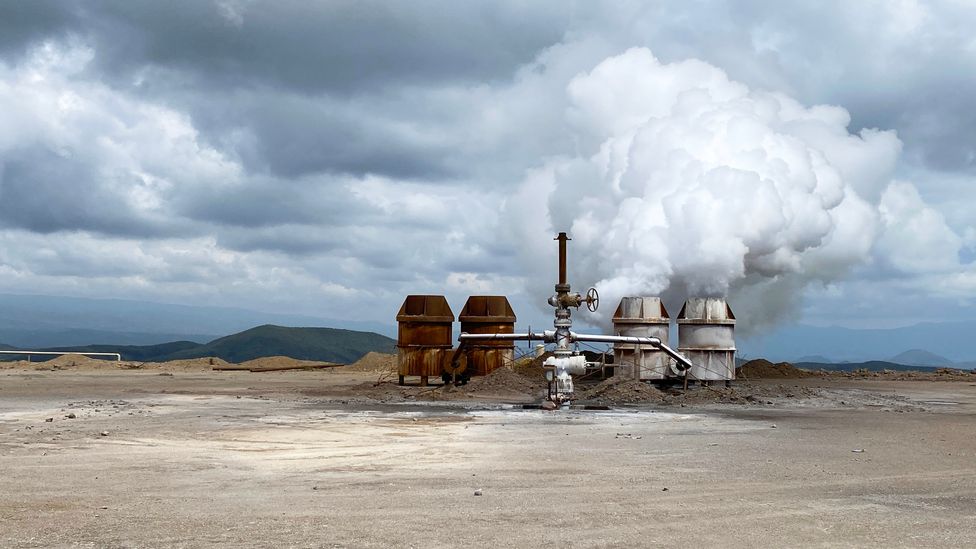 In the volcanic region of East Africa’s Great Rift Valley, tectonic shifts are tearing the continent apart – and releasing unimaginable quantities of clean energy.
In the volcanic region of East Africa’s Great Rift Valley, tectonic shifts are tearing the continent apart – and releasing unimaginable quantities of clean energy.Drive along the dusty dirt road that winds through Kenya’s Hell’s Gate National park, past the zebra, gazelles and giraffes, and you’ll see a plume of steam shooting skyward in the distance. Vehicles must sometimes swerve to avoid running over warthogs as they enter a vast valley dotted with dozens of steam vents – a factory of clouds.
Blasts of steam billow loudly, releasing heat from deep within the Earth. But even more powerful is the steam you don’t see: that which twists through miles of tubes to push past turbines, generating a type of clean energy that won’t run out for millions of years.
Atop this infernal labyrinth of tubes is Kenya’s Olkaria Geothermal Project, where a new addition to the powerplant is about to go online. At 86 megawatts, the Olkaria VI expansion will push the project’s total production to 791.5 megawatts. That’s about 27% of all the energy in Kenya, according to KenGen, the parastatal company that operates Olkaria. Already, Kenya relies on geothermal steam for 38% of its power – a greater proportion than any other nation.
“When Olkaria VI is complete, it will be the largest single geothermal plant in the world,” according to Cyrus Karingithi, who leads infrastructure and resource development for Olkaria.
Globally, geothermal energy is a $4.6bn (£3.3bn) industry, with more than 500 powerplants electrifying millions of households across South-east Asia, North America, Europe and beyond. Geothermal is, after all, the second most abundant source of energy in the world behind solar.
But it in terms of how much we tap this source of power, geothermal lags well behind. In 2016, the energy the world harvested from geothermal was just 4% that from solar, despite geothermal having some important advantages. Wind turbines are useless on a still day, and solar panels’ energy falls when the sun is covered by clouds and at night. Meanwhile, no matter the time of day, the Earth below us is steadily releasing vast quantities of heat, whatever the weather.
This is where the continent is breaking up – Anna Mwangi
To appreciate the potential of this heat, there is nowhere better to look than where it blasts through the surface in the towers of steam erupting from Hell’s Gate, around 90 kilometres (56 miles) north-west of Kenya’s capital, Nairobi.
Heat from the depths
On cloudy days here, it’s hard to tell which clouds come from the sky, and which ones come from the ground. One morning in February, Anna Mwangi, a geophysicist who works for firms including KenGen, is tasked with exploring for new geothermal drill sites. She points at a faint whisp of steam rising from a small hole in the rocky hillside.
“You can boil an egg in it,” she says with a smile. The area around Olkaria is teeming with natural geothermal vents such as these, some hot enough they burn to the touch. The steam, Mwangi explains, is what gives Hell’s Gate National Park its name: The landscape looks like the underworld is boiling over.
This energy is coming from the Earth – and it’s essentially limitless – Juliet Newson
In a way, it is. Some 3,000 kilometers (1,860 miles) down lies the Earth’s core, with temperatures hotter than the surface of the Sun. That heat travels upward through the Earth’s thick mantle, to the planet’s outermost layer – the crust. In places where tectonic plates – consisting of the Earth’s crust, and the upper mantle – are being pushed together or torn apart, this heat rises closer to the surface. One such place is Africa’s Great Rift Valley, which runs 7,000km (4,350 miles) across the eastern side of the continent.
“This is where the continent is breaking up,” says Mwangi, gesturing to the rocky ridges with deep gorges in between them. These are the visible signs of two vast tectonic plates slowly inching apart. “This is an active process that will go on for several millions of years to come,” she says. “In some millions of years if you come here, this will be an ocean.”
But in the meantime, this tectonic movement can be exploited for the energy it releases. As tectonic plates move they cause fissures – breaks in the Earth’s crust that allow underground water to interact with super-heated rock, turning it into steam. These fissures create pathways up to the Earth’s surface, where they form hot springs, geysers or steaming geothermal vents. Here in the Great Rift Valley, much of that heat is trapped just beneath the surface.
“This energy is coming from the Earth – and it’s essentially limitless,” says Juliet Newson, director of the Iceland School of Energy at Reykjavik University. “Kenya has got a really good resource and that’s the Rift Valley. You’ve got this [incredible] heat that’s so near the surface.” In other parts of the world, you’d have to drill several kilometers or more to find equivalent temperatures.
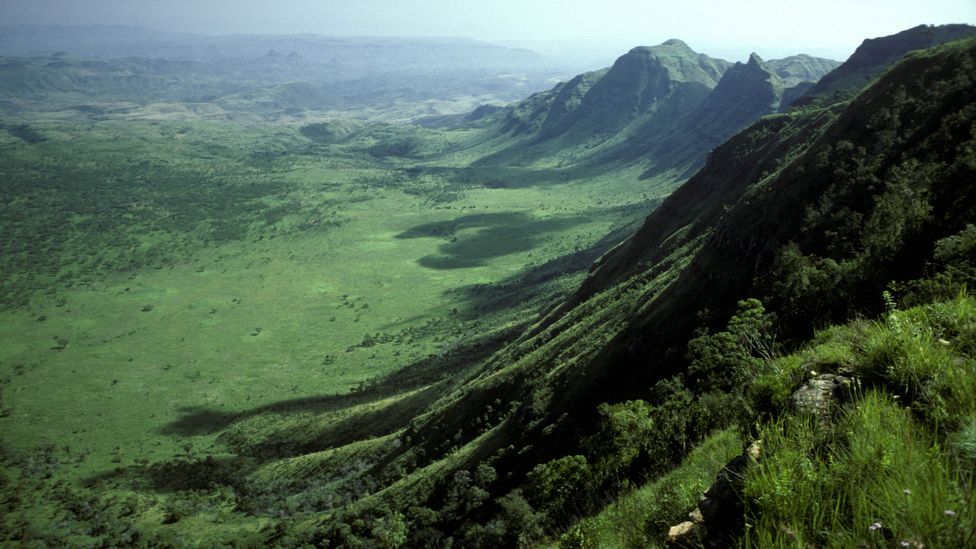
In East Africa’s Great Rift Valley, continental tectonic plates are slowly moving apart (Credit: Alamy)
Harnessing this energy for electricity is very simple, says Karingithi. “The way we do it at Olkaria, you separate the water from the steam. The steam you take to the turbine, which rotates and generates electricity.”
The turbines at Olkaria V whirl at 3,000 rotations per minute, too fast for the human eye to follow. Inside a small control room, two engineers work in 12-hour shifts, staring at a dozen monitors with data from the plant.
Kenya started early. We explored from the 1950s, so we’ve had many decades of studies and development and successes – Anna Mwangi
“What is your output today?” Karingithi asks them. One consults a computer screen: “158 megawatts.” That’s about 5% of the electricity capacity in the country.
All told, Olkaria generates about a quarter of Kenya’s power, transmitting some of it nearly 500km (310 miles) south-east to Kenya’s port city of Mombasa, and a few hundred kilometers west toward the border with Uganda. Kenya is the eighth largest producer of geothermal energy in the world, behind nations such as the United States, the Philippines, Indonesia, Turkey and New Zealand. Already ahead of Iceland and Japan, it is set to overtake Mexico and Italy once Olkaria VI goes live.
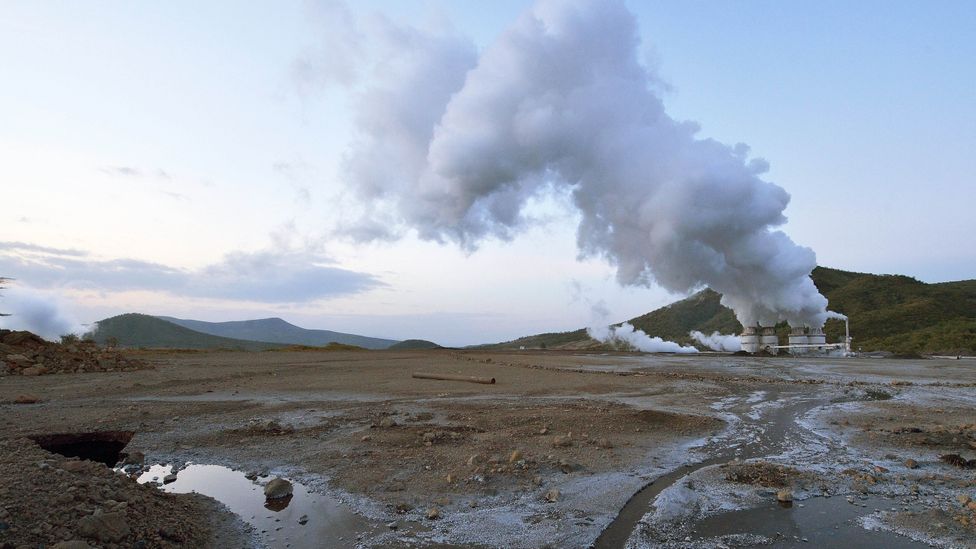
Steam has been tapped for power at Hell’s Gate for more than 70 years (Credit: Jacob Kushner)
This legacy has been a long time in the making. “Kenya started early,” says Mwangi. “We explored from the 1950s, so we’ve had many decades of studies and development and successes.”
And also failures. “Our first wells were terrible,” says Mwangi. “That was in 1956. Those wells produced low-pressure steam,” says Karingithi, and at the time, the technology wasn’t developed enough to use that steam.
The original Olkaria – Kenya’s first geothermal power plant, and the first in Africa – came a quarter of a century later, in 1981. Since the 1950s, KenGen, the parastatal company that operates Olkaria, has drilled 310 wells here in Hell’s Gate, 125 of which are still steaming today. Two massive new power plants came online in 2014 and 2015, substantially increasing output.
But their work is far from over. A quarter of Kenya’s population still lacks electricity. Blackouts are common, hampering the nation’s manufacturing sector and making it hard for students who need to study at night or parents to charge their cell phones. “We need to add more power so our nation is lighted like the rest of the world,” says Karingithi.
Drillling down
To find the next sources of steam, Mwangi and Karingithi trek as much as 50 kilometers (31 miles) in a single day. They look for sprigs of what they call “geothermal grass” – tall and thin, with green and yellow strands, which hint that heat and moisture may be lying underneath. They collect rock samples, test the water and take the temperature of the ground, all of which feeds into their calculations of whether a new well should be drilled in any particular spot.
Once you identify a strong location, “you need investors not to be faint-hearted”, says Karingithi. “Drilling a well costs $6m [£4.3m]. And if you miss, you’re sunk.” That is the major disadvantage of geothermal, he says. “The capital investment is very high and it puts off many people.”
For many geothermal engineers, the most exciting moment comes when you drill a new well – and strike steam. “When you drill a well they open the valve and let the fluid discharge into the atmosphere, the noise and the shaking is incredible – it’s just absolutely amazing,” says Newson, of what’s called a vertical discharge test. “The power that comes out of that well – for 20 years – that’s so exciting!”
At Olkaria, wells are tested for about two months to measure their flow rate. Then, the steam is directed either into an on-site mini plant, or through tubes to a larger plant such as Olkaria VI. Because Hell’s Gate is home to so much wildlife, in some places the pipes must be lifted several metres above the ground to allow giraffes and other wildlife to pass safely.
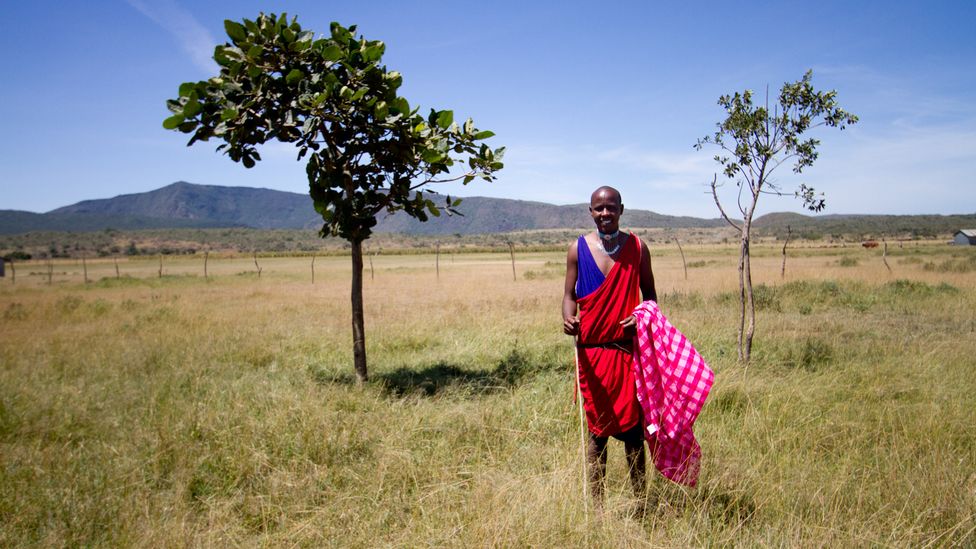
Geothermal may require less land use than other forms of power, but it has still displaced communities in Kenya’s Hell’s Gate region (Credit: Jacob Kushner)
At Olkaria, some of the electricity is generated right at the well sites. These small satellite wells tend to be two to three kilometers deep, each producing about 5 megawatts of energy – enough to power 50,000 Kenyan homes.
As the steam powers the turbines, the water gets injected back into the ground, to make sure the steam wells never run dry. With time it will reheat and return once more as steam.
Steaming ahead
In a country where demand for power outstrips supply, geothermal plants have a few advantages. For one, they can expand quickly. At Olkaria, “the pilot plant took maybe a year to build. The next 14 [wells] were built in four years,” says Victoria Nyaga, one of Newson’s former students who is now a sustainable energy engineer and who helped design some power plants at Olkaria. “It’s really fast-rolling once you get going.”
Their size helps too. The small plants that sit upon the wells are less than a football pitch in size and can be dismantled and moved from one well to another when more powerful steam sources are found. “That is a major advantage of geothermal – it requires a very small footprint,” says Karingithi. Geothermal requires significantly less land than wind, solar or coal.
That said, a single geothermal well may be tiny, but 300 of them spread across a valley crisscrossed by tubes and transmission lines, access roads and injection pools, makes Olkaria a behemoth. This poses a problem for the pastoralist Maasai who have grazed their cattle across this land on and off for centuries.
To make way for Olkaria’s expansions, Kengen relocated 1,181 Maasai from 155 households to a 1,700 acre stretch of land outfitted with houses, churches and schools. “We hope to get the next generation of scientists and engineers from [that same, Maasai] community,” says Karingithi.
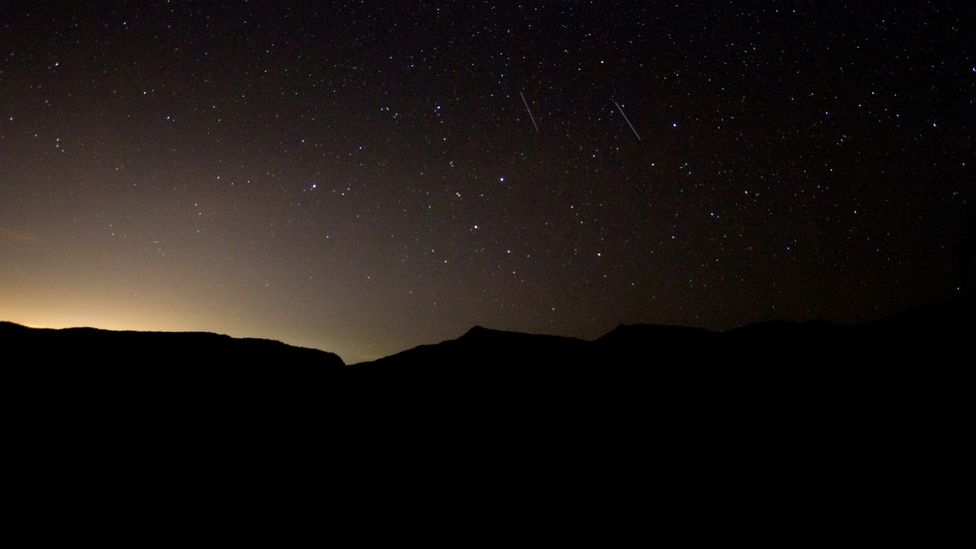
Those who rely on tourism in the Hell’s Gate region have concerns that expanding geothermal power might disrupt their livelihoods (Credit: Jacob Kushner)
So far, Olkaria employs 1,250 people but only about 50 are Maasai, and only 20 hail from the community that was displaced. Not many Kenyans have the opportunity to attend university, least of all rural pastoralists. Now, some of the 500 Maasai families who live around Suswa crater to Olkaria’s south worry they’ll soon be forced out, too. Another geothermal company has begun scouting for geothermal potential around the crater, formed by a now inactive volcano. The company believes the Suswa crater has the potential to generate 750 megawatts of geothermal electricity – as much as Olkaria produces today.
“In Olkaria, those people have been chased away,” says Kiano Sempui, a Maasai man and father of three who lives and grazes goats, sheep and cows at Suswa. “We are very sure that when the company comes here, sooner or later, the same will happen to us.”
What’s more, Sempui fears that geothermal would disrupt the small tourism industry he’s worked so hard to create. On weekends, dozens of Kenyan and foreign tourists head up the crater to visit a labyrinth of natural caves, hike along the crater rim for stunning views of the forest below them where leopards live, and to camp under the stars at the edge of a cliff. The conservancy’s tourism revenue pays teachers’ salaries, hospital bills and repairs roads.
“When the geothermal comes up, the conservancy will be destroyed, because there aren’t many tourists who will want to put up with all that noise,” says Sempui, in reference to the mind-shattering billowing of steam that erupts from geothermal wells when they are being tested or undergoing maintenance.
Closing the loop
As governments and foreign investors spend billions of dollars to connect more of East Africa to the grid, concern for rural pastoralists’ land is one of several challenges that will need to be addressed as people turn to geothermal to meet the energy demands of the region’s rapidly growing cities.
Another challenge is how to handle the CO2 released by the geothermal fluids and that can occur naturally in hot springs and steam vents. The amount of carbon released by geothermal varies widely from one project to the next, but overall it is still miniscule compared with burning fossil fuels – just 2.7% as much as burning coal, or 5% as much as natural gas.
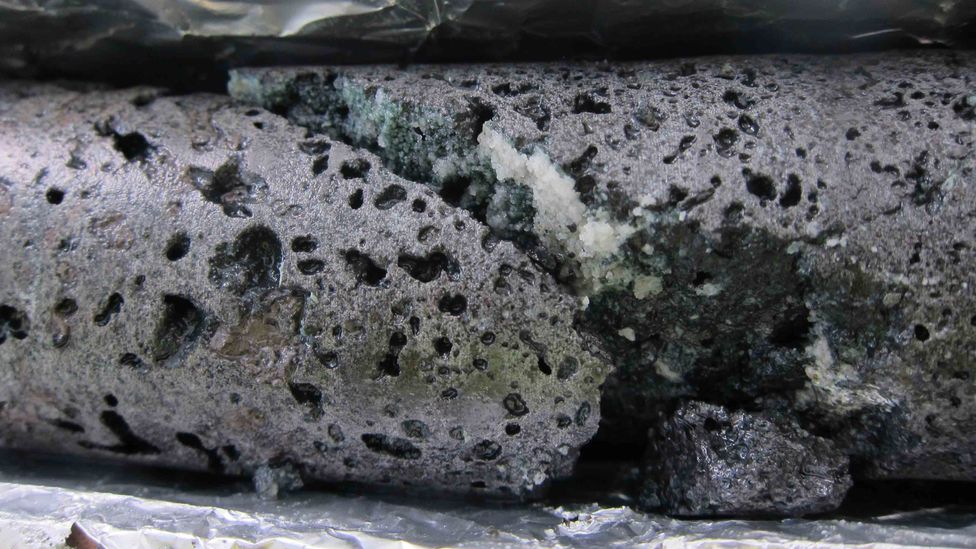
Geothermal firms in Iceland have sequestered the CO2 released by injecting it deep underground to form chalky white minerals (Credit: Sandra O Snaebjornsdottir)
Some plants, such as projects in Iceland, capture the carbon and inject it back underground, where it mineralises and becomes harmless. “A project in Iceland, called Carbfix, has been researching this for the last 10 years, and now a large proportion of CO2 from the large Hellisheidi Geothermal Power Station is reinjected deep into the basalt rocks where it forms new minerals which become part of the rocks,” says Newson. (Read more about how Iceland is turning CO2 into stone)
More problematic than the CO2, perhaps, is the reinjection of water deep into the rocks to replenish the steam. The water reinjected “has high concentrations of silica and salts [relative to cold groundwater], and sometimes toxic elements, such as arsenic, lithium, antimony, mercury, sulfur, and many others,” says Newson. In most cases, the water is injected deep enough that it doesn’t interfere with aquifers, but if done wrong it has the potential to pollute sources of drinking water.
And then there is the fact that through fracturing rocks, geothermal engineering can, and regularly does, cause seismic activity. On rare occasions, “you can feel the earthquakes. And people don’t like that,” says Newson. “That generates a lot of distrust and a lot of ‘not in my backyard,’ for which you can’t blame people.”
Although infrequent, sometimes the earthquakes are more serious. In November 2017, a geothermal plant caused a 5.5 magnitude earthquake in Pohang, South Korea that left 1,700 people displaced when water injections fractured a previously unknown fault line. Better monitoring and risk management could help avoid large earthquakes like this in the future.
Digging deep
Because geothermal electricity is only a little more than a century old, unlike fossil fuels, its future will most likely be longer than its past. But there’s much disagreement over what the next frontier should be.
Most existing geothermal plants “require a moderately hot reservoir – hot springs, geysers and other geothermal features,” says Newson. These are in essence the “low-hanging fruit” of geothermal.
“Anywhere you go, if you drill into the Earth deep enough, it’s pretty hot,” says Newson. “So why don’t we drill deep, fracture it, and get the heat out? It’s really tempting. Drilling is fun! But honestly, it’s really hard to make it work. It’s hard to get the rocks to fracture in the right direction.”
For example, one deep drilling initiative in Iceland that goes around 4.6km (2.9 miles) down has met some tough challenges. “There’s some harsh chemistry involved, and the equipment is all getting destroyed,” says Nyaga. The geothermal fluids dissolve gases such as CO2 that come from the underlying magma. And with temperatures surpassing 400C, these fluids also dissolve minerals out of the rocks. This makes the fluids highly corrosive, and they can cause damage to metal drilling equipment, pipes and cement that holds the equipment in place.
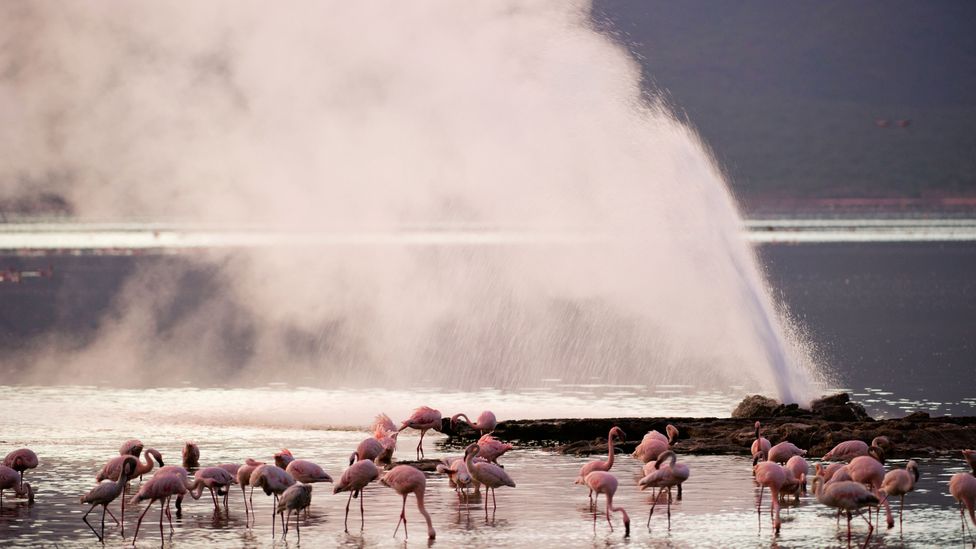
Geothermal energy might be most prominent in areas with hot springs and geysers, but even in cooler climes it can provide significant clean energy (Credit: Alamy)
While some engineers race to drill deeper, others think it better to cool off. So-called low-temperature geothermal systems with smaller outputs can be developed inexpensively in places where big powerplants cannot.
Already, “China is one of the top nations for geothermal heat,” says Nyaga, and many other countries are experimenting with new ways to generate power from water barely warm enough to brew your tea.
In theory, geothermal power can be produced virtually anywhere you can drill deep enough to release it. Newson says it might someday even be possible to produce geothermal power from the bottom of the sea. Since most of Earth’s volcanic activity occurs in the middle of the oceans, where tectonic plates converge or collide, the water there is plenty hot enough to power a turbine.
While Kenya leads Africa as far as tapping geothermal power, the same geological features that power Olkaria exist in half a dozen other nations up and down the Great Rift. Already, KenGen operates 22 wells in Ethiopia and will soon be tapping steam in Djibouti, too.
Across the globe, opportunities for geothermal power exist wherever tectonic plates collide. Many of these sites are in the Global South. “East Africa and Asia – there’s a lot of potential in the Philippines and Indonesia,” says Nyaga.
But while these regions might have the most accessible hot geothermal energy, the growing technical expertise in low-temperature geothermal means that more or less anywhere you stand in the world, you don’t have to look far to find evidence of the immense power of the Earth’s heat.
—
The emissions from travel it took to report this story were 98kg CO2, travelling by car. The digital emissions from this story are an estimated 1.2g to 3.6g CO2 per page view. Find out more about how we calculated this figure here.
By Jacob Kushner
—
Join one million Future fans by liking us on Facebook, or follow us on Twitter or Instagram.


